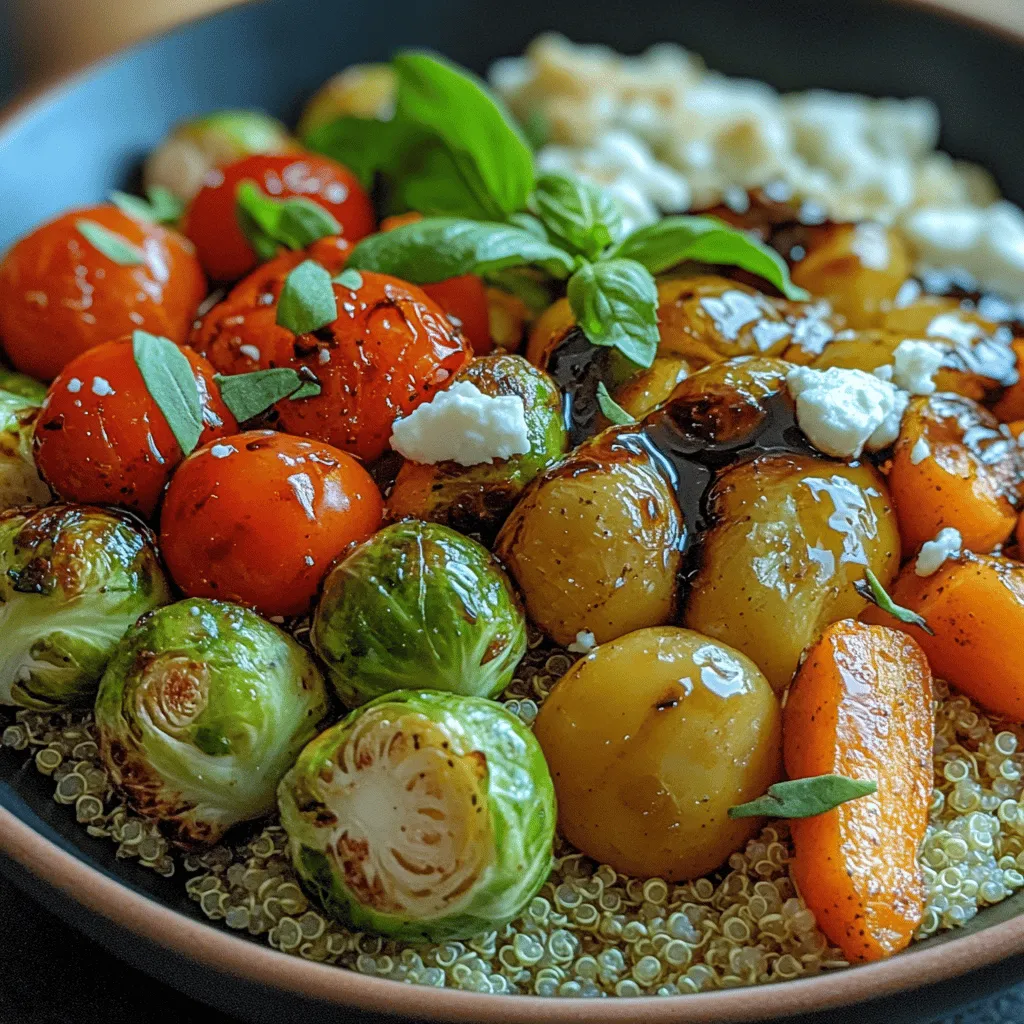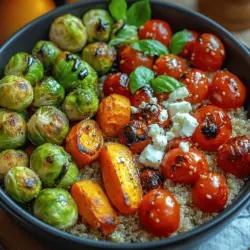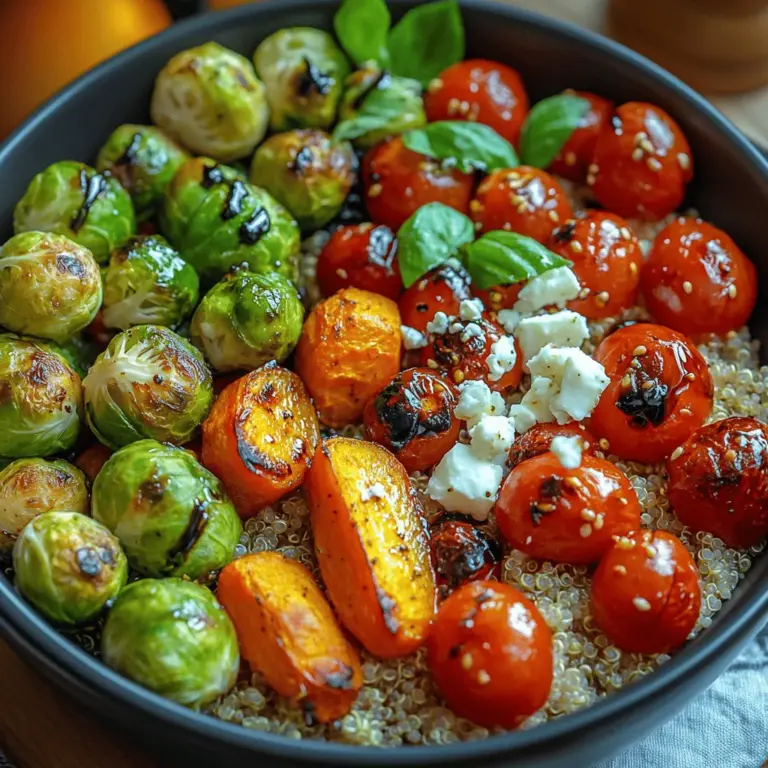Introduction
In the world of healthy eating, a balanced diet often begins with vibrant vegetables. The Balsamic Roasted Veggie Bowl is a celebration of seasonal produce, showcasing an array of colorful vegetables combined with the rich flavors of balsamic vinegar. This dish not only offers a nourishing meal but also provides a delightful culinary experience, making it perfect for both casual dinners and special occasions.
Whether you’re a seasoned chef or a cooking novice, this dish is approachable and easy to customize according to your taste preferences. The Balsamic Roasted Veggie Bowl is not just a meal; it’s an opportunity to explore the beauty of vegetables and the intricate flavors they can impart when combined with a few quality ingredients. The sweet and tangy profile of balsamic vinegar elevates the dish, creating a perfect harmony between flavors and textures.
In this article, we will explore the step-by-step process of creating this delicious bowl, the health benefits of the ingredients, and tips for customization. From the vibrant colors of the vegetables to the rich, tangy balsamic dressing, every element of this recipe is designed to excite your palate and nourish your body.
Understanding the Ingredients
The Power of Vegetables
The foundation of the Balsamic Roasted Veggie Bowl is, of course, the vegetables. Each vegetable contributes its own unique flavor and nutritional benefits. Here’s a closer look at some of the key players in this dish:
– Brussels Sprouts: These tiny cabbages are rich in vitamins C and K, fiber, and antioxidants. Roasting Brussels sprouts enhances their natural sweetness and creates a satisfying crunch when cooked properly.
– Cherry Tomatoes: Bursting with flavor, cherry tomatoes are a good source of vitamins A and C, lycopene, and other antioxidants. Roasting intensifies their sweetness, making them a delightful addition to any dish.
– Bell Peppers: Available in various colors, bell peppers are low in calories but high in nutrients. They provide vitamins A, C, and B6, along with antioxidants. Roasting bell peppers brings out their natural sweetness and adds a smoky flavor.
– Red Onion: Known for its sharp, tangy flavor, red onion is also packed with vitamins C and B6, as well as antioxidants. Roasting mellows their flavor, turning them sweet and caramelized.
– Zucchinis: These versatile squash are low in calories and high in water content, making them a great option for hydration. Roasting zucchini enhances its flavor, providing a tender yet slightly crisp texture.
– Carrots: Rich in beta-carotene, fiber, and vitamins K and B6, carrots add a natural sweetness to the bowl. When roasted, they become tender and caramelized, bringing depth to the dish.
Roasting vegetables not only enhances their flavor but also transforms their texture, creating a delectable contrast between the crispy edges and tender centers. This technique is crucial in elevating the overall taste of the Balsamic Roasted Veggie Bowl.
The Role of Balsamic Vinegar and Olive Oil
The dressing for the Balsamic Roasted Veggie Bowl primarily consists of balsamic vinegar and olive oil, both of which play essential roles in flavor and health.
– Balsamic Vinegar: This vinegar has a distinct sweet and tangy flavor profile, which can elevate any dish. It is known for its potential health benefits, including antioxidant properties that may help reduce inflammation. A high-quality balsamic vinegar can transform the vegetables by adding depth and complexity to the dish.
– Olive Oil: Using quality extra virgin olive oil is crucial in this recipe, as it not only contributes to the flavor but also provides healthy fats. Olive oil is rich in monounsaturated fats, which are known to support heart health. It also contains antioxidants and anti-inflammatory properties, making it a staple in Mediterranean diets.
Combining balsamic vinegar and olive oil creates a delicious marinade that coats the vegetables and enhances their natural flavors while roasting. The balance of acidity from the vinegar and the richness of the olive oil results in a harmonious dressing that ties the entire dish together.
Grains as a Base
To make the Balsamic Roasted Veggie Bowl a complete meal, we need a nutritious grain as a base. Common choices include quinoa and brown rice, both of which provide essential nutrients and contribute to satiety.
– Quinoa: Often hailed as a superfood, quinoa is a complete protein, meaning it contains all nine essential amino acids. It is also gluten-free and packed with fiber, vitamins, and minerals. This ancient grain has a slightly nutty flavor and a fluffy texture when cooked, making it an excellent choice for a veggie bowl.
– Brown Rice: A whole grain that retains its bran and germ, brown rice is a good source of fiber, vitamins B1 and B6, and minerals like magnesium and phosphorus. It has a chewy texture and a mild flavor, providing a hearty base that pairs well with roasted vegetables.
Both quinoa and brown rice offer unique nutritional benefits, so the choice between them can depend on personal preferences or dietary restrictions. Incorporating grains into the Balsamic Roasted Veggie Bowl enhances the dish’s nutritional profile and makes it more filling.
Preparation Steps
Preheating the Oven
Before diving into the preparation of the ingredients, it’s essential to preheat your oven. Proper preheating is crucial for achieving optimal roasting results. When vegetables are placed in a hot oven, they begin to caramelize, developing rich flavors and textures.
Set your oven to preheat at 425°F (220°C). This temperature is ideal for roasting as it allows for a good balance between cooking the vegetables thoroughly while also ensuring they get crispy edges. An adequately preheated oven will help lock in the flavors and moisture of the vegetables, resulting in a delectable Balsamic Roasted Veggie Bowl.
Preparing the Vegetables
Once the oven is preheated, it’s time to prepare the vegetables. Here are some key techniques for cutting and preparing them for roasting:
1. Wash and Dry: Start by thoroughly washing all the vegetables under running water to remove any dirt or pesticides. After washing, pat them dry with a clean towel. This step is crucial as excess moisture can lead to steaming instead of roasting.
2. Cutting Techniques: Each vegetable may require a different cutting technique to ensure even cooking. Here are some tips:
– Brussels Sprouts: Trim the ends and slice them in half.
– Cherry Tomatoes: Leave them whole or halve them for quicker roasting.
– Bell Peppers: Remove the seeds and membranes, then slice them into strips or bite-sized pieces.
– Red Onion: Peel and cut into wedges or thick slices.
– Zucchinis: Slice into rounds or half-moons, depending on your preference.
– Carrots: Peel and slice them into thin rounds or sticks for even cooking.
3. Uniform Sizes: Aim for uniform sizes when cutting the vegetables. This will help ensure they cook evenly and at the same rate. If you have larger pieces mixed with smaller ones, the smaller pieces may burn while the larger ones remain undercooked.
Creating the Marinade
The next step is to create the balsamic marinade that will enhance the flavor of the vegetables. This simple yet effective marinade can be prepared in just a few minutes. Here’s how to make it:
1. Ingredients: You will need balsamic vinegar, extra virgin olive oil, minced garlic, salt, pepper, and any additional herbs or spices you’d like to include.
2. Mixing the Marinade: In a mixing bowl, combine ¼ cup of balsamic vinegar with 3 tablespoons of extra virgin olive oil. Add 2-3 cloves of minced garlic, salt, and pepper to taste. For added flavor, consider incorporating dried herbs like oregano, thyme, or rosemary. Whisk the mixture until it is well combined.
3. Marinating the Vegetables: Place the prepared vegetables in a large mixing bowl or a resealable plastic bag. Pour the marinade over the vegetables and toss them until they are evenly coated. Allow the vegetables to marinate for at least 15-30 minutes, although longer is better as it will allow the flavors to meld.
4. Customization Options: Feel free to experiment with different herbs and spices based on your flavor preferences. You can add a pinch of red pepper flakes for a spicy kick or a drizzle of honey for a touch of sweetness. The beauty of this dish lies in its versatility.
By taking the time to create a flavorful marinade, you set the stage for a truly delicious Balsamic Roasted Veggie Bowl that is bursting with flavor.
With all the preparation complete, you’re now ready for the roasting process, where the magic happens. In the next part of the article, we will delve into the best practices for arranging the vegetables on the baking sheet, the timing and techniques for roasting, and how to cook the grains that will serve as the base for your bowl. Stay tuned for a deep dive into the roasting process that will transform your marinated veggies into a flavorful masterpiece.

Quinoa Preparation
Cooking quinoa perfectly is essential for achieving the ideal texture in your Balsamic Roasted Veggie Bowl. Follow these simple steps to ensure your quinoa turns out fluffy and flavorful.
1. Rinse the Quinoa: Start by rinsing 1 cup of quinoa under cold water using a fine-mesh strainer. This removes the natural coating called saponin, which can impart a bitter taste. Make sure to rub the quinoa gently between your fingers while rinsing for thorough cleaning.
2. Cook the Quinoa: In a medium saucepan, combine the rinsed quinoa with 2 cups of water or vegetable broth for added flavor. Bring the mixture to a boil over medium-high heat. Once boiling, reduce the heat to low, cover the pan, and let it simmer for about 15 minutes.
3. Let It Rest: After 15 minutes, remove the saucepan from heat but keep it covered. Let the quinoa sit for an additional 5 minutes to steam. This step is crucial as it helps the grains expand and become fluffy.
4. Fluff and Season: Finally, remove the lid and fluff the quinoa gently with a fork. If desired, season with a pinch of salt or a drizzle of olive oil to enhance the flavor.
Common Mistakes to Avoid in Grain Preparation
To achieve the best results, avoid these common mistakes when preparing quinoa:
– Skipping the Rinse: Neglecting to rinse quinoa can lead to a bitter taste. Always rinse before cooking.
– Incorrect Water Ratio: Using too much or too little water can result in mushy or undercooked quinoa. Stick to the 2:1 water-to-quinoa ratio.
– Not Letting It Rest: Skipping the resting time after cooking can lead to a denser texture. Allowing it to steam helps achieve fluffiness.
Brown Rice Alternatives
Brown rice is another excellent base for your Balsamic Roasted Veggie Bowl. Here’s how to prepare it and why you might choose it over white rice.
Cooking Methods and Timing for Brown Rice
1. Rinse and Soak: Similar to quinoa, rinse 1 cup of brown rice under cold water. Soaking for 30 minutes can enhance cooking efficiency, although it’s not necessary.
2. Cook the Rice: In a saucepan, combine the rinsed rice with 2.5 cups of water. Bring to a boil, then reduce to low heat, cover, and simmer for 45-50 minutes until the rice is tender and the water is absorbed.
3. Fluff and Serve: After cooking, let the rice sit for 10 minutes before fluffing it with a fork. This resting period allows the grains to separate for a better texture.
Advantages of Using Brown Rice Over White Rice
Choosing brown rice over white rice has several benefits:
– Higher Nutritional Value: Brown rice retains its bran and germ layers, making it richer in fiber, vitamins, and minerals.
– Lower Glycemic Index: It has a lower glycemic index than white rice, which helps regulate blood sugar levels.
– Longer Satiety: The fiber content in brown rice promotes feelings of fullness, potentially aiding in weight management.
Assembling the Balsamic Roasted Veggie Bowl
Now that you have your base of grains ready, it’s time to assemble your Balsamic Roasted Veggie Bowl.
Layering the Ingredients
A beautifully layered bowl not only pleases the eye but also enhances the flavor profile of the dish. Here’s how to create a visually appealing bowl:
1. Base Layer: Start with a generous scoop of quinoa or brown rice as your base. This provides a hearty foundation for your bowl.
2. Add Roasted Vegetables: Next, arrange your roasted vegetables—such as bell peppers, zucchini, and carrots—over the grains. This layering allows the flavors of the veggies to seep into the grains beneath.
3. Choose Your Sauces: Drizzle a balsamic glaze over the veggies to infuse them with flavor. You can also add a splash of olive oil for richness.
The Significance of Layering for Flavor Integration
Layering is not just for aesthetics; it plays a crucial role in flavor integration. When you layer the ingredients, each bite captures the essence of the grains, veggies, and sauce, creating a delightful balance. The warmth of the roasted veggies melds with the grains, allowing the balsamic glaze to enhance the overall taste.
Garnishing Your Bowl
A few finishing touches can elevate your Balsamic Roasted Veggie Bowl to new heights.
The Impact of Fresh Herbs
Adding fresh herbs like basil or parsley not only enhances the presentation but also adds a burst of freshness and flavor. Simply chop a handful and sprinkle over the top before serving. The herbs complement the balsamic glaze beautifully and brighten the dish.
Exploring the Option of Adding Crumbled Feta Cheese
For those who enjoy a creamy texture, consider adding crumbled feta cheese as a garnish. Its tangy flavor contrasts nicely with the sweetness of the roasted veggies and balsamic glaze. It also provides a boost of protein and calcium, making your bowl even more satisfying.
Health Benefits of the Balsamic Roasted Veggie Bowl
The Balsamic Roasted Veggie Bowl is not only delicious but also packed with health benefits.
Nutritional Analysis
This bowl is a nutrient powerhouse, providing a balanced mix of macronutrients and vitamins. Here’s a rough breakdown per serving:
– Calories: Approximately 400-500, depending on the grains and toppings used.
– Protein: About 12-15 grams, especially if topped with chickpeas or feta.
– Fiber: 8-10 grams, promoting digestive health.
– Vitamins: Rich in Vitamin A, C, and K from the variety of vegetables.
Benefits of Fiber-Rich Meals
Fiber-rich meals like this bowl help improve digestion, regulate blood sugar levels, and promote a feeling of fullness, which can prevent overeating. Incorporating fiber into your diet is crucial for maintaining overall health.
Incorporating into a Balanced Diet
The versatility of the Balsamic Roasted Veggie Bowl allows it to fit into various dietary lifestyles:
– Vegetarian: Naturally vegetarian, as it’s loaded with plant-based ingredients.
– Gluten-Free: When using quinoa or gluten-free grains, this bowl is suitable for gluten-free diets.
– Balanced Meal: To make it a complete meal, consider adding a protein source such as chickpeas, grilled chicken, or tofu.
Suggestions for Portion Sizes and Meal Frequency
To incorporate this dish into your meal rotation, aim for a serving size that fits your dietary needs. A standard serving can be one cup of grains topped with 1-2 cups of roasted veggies. Enjoy it as a lunch or dinner option, or even as a meal prep choice for the week.
Customization Options
One of the best aspects of the Balsamic Roasted Veggie Bowl is its adaptability. Here are some ways to customize your dish.
Vegetable Substitutions
Feel free to swap out vegetables based on what’s in season or what you have on hand:
– Seasonal Vegetables: Use squash in the fall, asparagus in the spring, or cherry tomatoes in the summer for a fresh twist.
– Protein Sources: Add protein-rich options like chickpeas, lentils, or grilled chicken for a heartier meal.
Flavor Enhancements
Elevate your dish further with additional spices or sauces:
– Spices: Consider adding garlic powder, smoked paprika, or crushed red pepper for extra depth of flavor.
– Sauce Variations: Experiment with different sauces, such as tahini dressing or a zesty lemon vinaigrette, for alternative flavor profiles.
Conclusion
The Balsamic Roasted Veggie Bowl is more than just a meal; it’s a versatile dish that embraces the freshness of vegetables and the richness of balsamic flavors. With straightforward preparation and endless customization possibilities, this recipe encourages everyone to enjoy healthy eating without sacrificing taste. The combination of roasted veggies and wholesome grains creates a satisfying bowl that can be enjoyed year-round, making it a staple in any home kitchen. Whether you choose to follow the recipe as is or make it your own, this dish is sure to delight your palate and nourish your body. Enjoy your culinary journey with the Balsamic Roasted Veggie Bowl, and embrace the flavors of fresh, wholesome ingredients.

